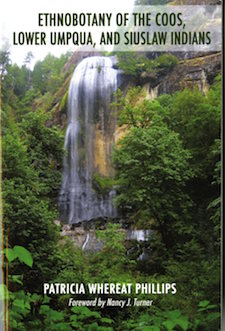Ethnobotany of the Coos, Lower Umpqua, and Siuslaw Indians
Last Updated on November 21, 2022 by

by Patricia Whereat-Phillips
SBN 978-0-87071-852-6
Oregon State University Press, Corvallis, Oregon, 2016
This small and well-researched text introduces the reader to the detailed botanical knowledge of Native Americans of the central and southern Oregon coast—the Coos, Lower Umpqua, and Siuslaw Tribes. Prior to this book, very little research had been published about these people and their relationship to plants. The culture and languages of these central and southern Oregon coastal people is distinct from their neighbors to the north and south, pointing to the uniqueness and value of this new published research. Whereat-Phillips, herself, is of Milluk Coos heritage and speaks of growing up connected to her cultural heritage through the annual summer berry harvest near her home in Coos Bay. She also holds a BS in biology from OSU and a MA in Linguistics from UO focusing on the Hanis Coos language (one of three languages spoken by these people, the others being Milluk and Siulslaw), and worked for several years as the Cultural Resources Director for the Confederated Tribes of the Coos, Lower Umpqua, and Siuslaw. This project inspired her to do a detailed search through old ethnographic records of early explorers and to have conversations within her own community to record their living knowledge about the plants.
The book opens with a forward by the renowned ethnobotanist Nancy Turner, Professor Emeritus of Ethnobiology at the University of Victoria. The choice is appropriate because, like previous books (e.g., by Turner, M. Kat Anderson, and other ethnobotanists), this work recognizes that native people interacted with their environment, using fire and other strategies that favored the species they used for food, fiber, shelter, etc. Though specific horticultural practices are not well recorded for these groups of people, both the Siuslaw and Hanis Coos languages include a word meaning “garden,” implying a relationship of tending and care, rather than of being merely hunter-gatherers, as Western scientists formerly posited. As a teacher at the Columbines School of Botanical Studies in Eugene, Oregon, my special focus is in ethnobotany, using wild food plants, and incorporating indigenous horticultural methods into present land management practice on individual and community scales. Respecting and learning from the First People is essential to my work and my vision of an ecologically sustainable future, and this book is a valuable resource towards those goals.
The opening chapter describes the traditional lands of the Coos, Lower Umpqua, and Siuslaw, their cultural and language distinctions and similarities, and an aid to pronunciation of indigenous words. Subsequent chapters describe their traditional life, including housing style, fishing techniques and materials, and their seasonal movements across the landscape as they tended their wild gardens. We also learn how this way of life was interrupted through forced migration to reservations and about the few native informants who told stories and provided information about their cultures to ethnographers.
The core of the book consists of plant descriptions, organized under six headings: trees; shrubs; forbs; ferns, fern allies, and mosses; fungi and seaweeds; and unidentified plants. Each description includes common and Latin names, any known names in Hanis, Milluk, and Siuslaw, and has a brief and simple botanical description, including the plant family. The indigenous plant names can exemplify subtleties of cultural importance based on how things are named; for example, Douglas fir (Pseudotsuga menziesii) has four names: for the tree in general, for old growth trees, the bark of old growth trees, and for young trees. Each plant entry is organized based on use: medicine, food, fiber, technology, and other. Only a few of the plants are pictured, with a clear black and white photo near the description, and occasionally a historical illustration or photo of people showing their traditional way of life. Finally, a short Appendix on basketry includes a detailed table describing the numerous types of woven products and the indigenous names for them. The book concludes with a well-documented Notes and Bibliography.
This book was born from Whereat-Phillips’ own culture and curiosity, and the personal nature of her work shows. Compared with other ethnobotany books, this one feels more intimate. Perhaps this is because, as Whereat-Phillips states, “I have come to know their indigenous names, and when I see these plants in the forests and dunes they seem more like old friends than background greenery.” Her descriptions are full of life and action, teeming with detailed stories, myths, historical tidbits, and in-depth explanations of how plants are used. Phillips’ memories occasionally spruce up the pages, such as her childhood experience gathering cascara (Rhamnus purshiana) bark to sell as a laxative. In another example, she explains that salmonberry (Rubus spectabilis) shoots are a valuable source of spring greens and gives a detailed description of what kind of shoot is eaten, how it is prepared, what other foods it is combined with, and why. As a gatherer of salmonberry shoots myself, reading her account strengthened my understanding of how this plant contributed to the traditional diet, with invaluable details that helped me modify my own use of the plant.
The dimensions are 9×6” and about ½” thick, making this book light and easy to carry, great for use by hikers, who are knowledgeable about basic plant identification, to enrich their understanding of plant uses, Native peoples, and history. Because many of the plants are widespread across western Oregon, and many in Washington too, it should appeal to anyone in the Pacific Northwest who wants to understand the cultural context and details of traditional indigenous uses of plants in our region.
—Heron Brae, Emerald Chapter.
